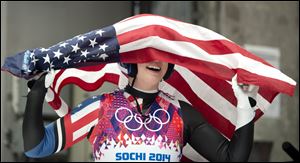
Hamlin wins United States' first individual luge medal
2/11/2014
Erin Hamlin of the United States celebrates with the American flag after finishing her final run to win the bronze medal in the women's singles luge competition at the 2014 Winter Olympics.
KRASNAYA POLYANA, Russia — The first few days of the Sochi Olympics brought medals for Americans in sports making their debut here — on the jumps and rails of the slopestyle course at someplace called the Extreme Park. What is purer and simpler, though, than luge? Stand at the top of a slick track of ice, jump on a tiny sled — and go. Fastest to the bottom wins.
For a half-century, since the sport first appeared on the Olympic program at the 1964 Innsbruck Games, the U.S. waited for an individual luger to take a medal. That was supposed to happen in 2010, when Erin Hamlin was the reigning world champion. She finished 16th.
So what happened today night made a different kind of history. Four years after that disappointment and 50 years after luge became an Olympic sport, Hamlin brought home a bronze medal in what amounts to a long-awaited breakthrough for USA Luge.
“Luge isn’t the biggest sport at home, and we’ve never won an individual medal,” Hamlin told reporters. “Hopefully this gives it a boost. I’m happy to pave the way to the future.”
Gold and silver went to athletes from the sport’s pre-eminent nation, Germany. Natalie Geisenberger was first in 3 minutes 19.768 seconds — a dominant 1.139 seconds better than teammate Tatjana Huefner, who won gold four years ago in Vancouver.
Hamlin, a 27-year-old from tiny Remsen, N.Y., had long been in the Germans’ class. When she won the 2009 world championship, she became a favorite for the Vancouver Games.
But in training leading up to those Olympics, Georgian luger Nodar Kumaritashvili died in a crash on the blazing track in Whistler, British Columbia. Officials moved the start lower for competition, and Hamlin could never adjust to the new configuration.
She came here, then, thinking her best chance had passed. And with each passing Games, there had to be those wondering whether an American luger would ever win a medal. All four U.S. luge medals — two silvers and two bronzes — had come in the doubles event.
“It’s nice to break the streak,” said Tony Benshoof, who was one of three Americans to finish fourth in an individual event. “I’ve always known that Erin could get on the podium. It just hadn’t happened yet.
“It’s great for the organization. It’s great for her. . . . She’s kind of a master of high-pressure races. She’s a good closer. After the third run, I knew barring some major catastrophe she had it in the bag.”
Given how Geisenberger has been sliding, gold never seemed realistic for Hamlin. Geisenberger won seven of eight races on the World Cup circuit this year, and she held a commanding lead after Monday’s first two heats. When she ripped off a track-record run of 49.765 seconds in the third heat, her lead was virtually insurmountable.
Still, Hamlin was third entering the fourth and final heat. She merely had to maintain her position to make history. When she made it down in 50.348 seconds — giving her a four-run total time of 3:21.145 — only Geisenberger and Huefner remained. The medal secured, she threw her hands in the air.
“It’s going to take a little while to sink in,” Hamlin said. “I was the first American woman to win at worlds, so to be able to do this, I’m hopefully paving the way for future generations of female lugers.”